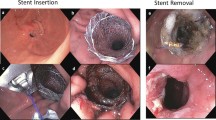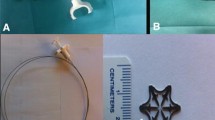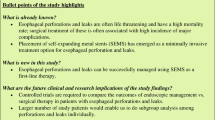Abstract
Background
Self-expanding metallic stents (SEMS) are useful for treating leaks after bariatric procedures but stent migration (12 to 40 %) remains a problem. Suture fixation has been used to minimize migration but has attendant risks of transmural penetration. We hypothesized that submucosal injection would decrease the risk of full thickness suture penetration while still providing greater pullout forces than endoscopic clipping.
Methods
Porcine explant models and 155 mm SEMS were used with a force meter to measure the pullout forces required to dislodge the stent. Stents were first deployed without fixation and this pullout force acted as a control. The explants were then randomized to receive fixation with clips, endoscopic suturing with submucosal elevation, or endoscopic suturing without submucosal elevation. The pullout force was again measured and the ratio of the experimental to control pullout forces was used as a measure of the efficacy of the fixation.
Results
Endoscopic suture fixation after submucosal injection resulted in statistically significant increased pullout force compared to clip fixation (n = 5; mean force ratio 462 %; 95 % confidence interval [CI] 281–643 %; p < 0.01). Endoscopic suturing fixation without submucosal injection also resulted in statistically significant increased pullout force (n = 5; mean force ratio 765 %; 95 % CI 258–632 %; p < 0.01). Fixation with clips did not result in significantly increased pullout force compared to no fixation (n = 5; mean force ratio 108 %; 95 % CI 56–159 %; p < 0.01). Submucosal injection also eliminated full thickness suture penetration (0/10 submucosal injection; 7/10 no injection).
Conclusions
Endoscopic suture fixation of SEMS resulted in a statistically significant increase in pullout force necessary to displace the stents. Submucosal injection prior to suture fixation preserves the increased pullout force while minimizing the risk of transmural penetration with the potential for less risk of injury to mediastinal structures.








Similar content being viewed by others
References
Leenders BJ, Stronkhorst A, Smulders FJ, Nieuwenhuijzen GA, Gilissen LP (2013) Removable and repositionable covered metal self-expandable stents for leaks after upper gastrointestinal surgery: experiences in a tertiary referral hospital. Surg Endosc 27(8):2751–2759
Bakken JC, Wong Kee Song LM, de Groen PC, Baron TH (2010) Use of a fully covered self-expandable metal stent for the treatment of benign esophageal diseases. Gastrointest Endosc 72(4):712–720
Langer FB, Schoppmann SF, Prager G, Riegler FM, Zacherl J (2010) Solving the problem of difficult stent removal due to tissue ingrowth in partially uncovered esophageal self-expanding metal stents. Ann Thorac Surg 89(5):1691–1692
Rieder E, Dunst CM, Martinec DV, Cassera MA, Swanstrom LL (2012) Endoscopic suture fixation of gastrointestinal stents: proof of biomechanical principles and early clinical experience. Endoscopy 44:1121–1126
Holm AN, de la Mora Levy JG, Gostout CJ, Topazian MD, Baron TH (2008) Self-expanding plastic stents in treatment of benign esophageal conditions. Gastrointest Endosc 67(1):20–25
Ko HK, Song HY, Shin JH, Lee GH, Jung HY, Park SI (2007) Fate of migrated esophageal and gastroduodenal stents: experience in 70 patients. J Vasc Interv Radiol 18(6):725–732
Seven G, Irani S, Ross AS, Gan SI, Gluck M, Low D, Kozarek RA (2013) Partially versus fully covered self-expanding metal stents for benign and malignant esophageal conditions: a single center experience. Surg Endosc 27(6):2185–2192
Blackmon SH, Santora R, Schwarz P, Barroso A, Dunkin BJ (2010) Utility of removable esophageal covered self-expanding metal stents for leak and fistula management. Ann Thorac Surg 89(3):931–937
Funding
Apollo Endosurgery, Inc. supported this study with funding for porcine explants as well as supplying OverStitch™ devices, suture, and cinches.
Disclosures
Victor T. Wilcox, Albert Y. Huang, Nabil Tariq, Brian J. Dunkin have no conflict of interest.
Author information
Authors and Affiliations
Corresponding author
Rights and permissions
About this article
Cite this article
Wilcox, V.T., Huang, A.Y., Tariq, N. et al. Endoscopic suture fixation of self-expanding metallic stents with and without submucosal injection. Surg Endosc 29, 24–29 (2015). https://doi.org/10.1007/s00464-014-3640-5
Received:
Accepted:
Published:
Issue Date:
DOI: https://doi.org/10.1007/s00464-014-3640-5




